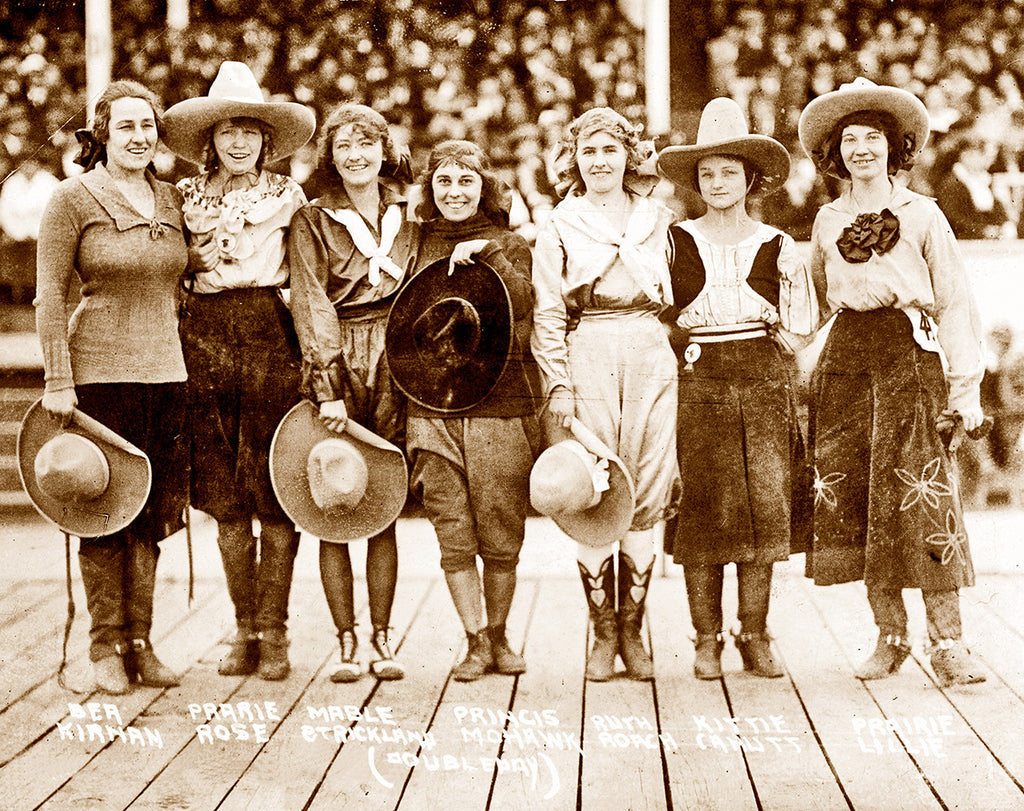Not Their First Rodeo
A cloud of romance surrounds the cowgirls and cowboys of the Old West. We love the stories of the hardened cowboy tenderly rescuing a calf stuck in a tangle of barbed-wire fencing, or the cowgirl who grew up riding sidesaddle but won barrel-racing medals in rodeo after rodeo, even against the men.
In real life, it wasn’t all that romantic. The men and women of the Old West worked hard. There was no end to the hard labor and long hours of riding the range, herding cattle, fixing fences, breaking broncs…not to mention weeks on a cattle drive. They worked until their hands were calloused and their joints sore from hours in the saddle. But they also played. There were the suppers around the bonfire, twangy love songs, and best of all, there were the rodeos. Both cowboys and cowgirls participated in these with enthusiasm and gusto.
At Home on the Range

The cowboy in this photo drank from his hat as his horse quenched its thirst in this calm mountain lake or pond. It’s easy to see how at home they were in their natural surroundings. No need for bottled water or drinking troughs! It was the way of a cowboy to be at home wherever his horse was.
The beautiful setting is probably part of the Z Bar T Ranch, better known as the Pitchfork Ranch, which is still located in the Greybull River valley in northwestern Wyoming. The ranch spreads across hundreds of acres of land nestled between mountainsides. In 1878, Count Otto Franc von Lichtenstein, who emigrated there from Germany, became the second settler in the valley. He fell in love with the area and built a cabin there. Within a year, there were hundreds of cattle grazing, herded there on a cattle drive from western Montana. The Count’s land became known as the Pitchfork Ranch. Rumor has it that Butch Cassidy stole his first horse there!
The photographer was the great Charles J. Belden (1886-1966), who chronicled western ranch life like no one else. He knew it from the inside out, having lived at, worked at, and managed the Pitchfork Ranch over some years. Belden took many of his western photos from the back of his pony, Pinky! (He used a unipod (think selfie-stick) to hold the camera steady!)
Babies Grew Up to Be Cowgirls

The early cowgirls broke a lot of rules. They weren’t supposed to be out riding horses or branding cattle. In the good old days, they would have been sitting inside the parlor, embroidering linens or serving tea. But in most places on the western frontier and especially on a ranch, there was neither the time nor inclination for such sensitivities.
The cowgirls of the past carried on in all sorts of ways. Some were sharpshooters like Annie Oakley, or Wild West Show performers like Lillian Smith, or bronc busters like Bonnie McCarroll, or rodeo players like the Pendleton cowgirls pictured above.
We know quite a lot about the rodeo women in the Cowgirls photo, each famous in her own right. They were superstars of the rodeo and competed in many of the rodeo circuits. Dressed in the cowgirl clothes of the day (10-gallon hats, boots, and embroidered dresses), they are identified as Ber Kirnan, Prairie Rose, Mabel Strickland, Princis Mohawk, Ruth Roach, Kittie Canutt, and Prairie Lillie.
Where do cowgirls go when the rodeo is over? Mabel Strickland’s rodeo fame took her to Hollywood, where she founded the Association of Film Equestriennes. Professional bronc rider Kitty Canutt was known as “Diamond Girl” or “Diamond Kitty” because of the diamond in a front tooth (that she removed when she was short her competition fees). “Diamond Kitty” married a famous cowboy who went on to be a Hollywood stuntman. Ruth Roach set hearts on fire with her silk bloomers and the hearts embossed on her cowgirl boots. Prairie Rose claimed fame when she became the first cowgirl to compete in bronc riding; she finished close to the top her first time out.
Ride ‘em, Cowgirl!

Bonnie McCarroll (1897-1929), pictured above, was a 20th century cowgirl who was well known for her skill at trick riding, steer riding, and bronc riding. She made rodeo history in 1922 by winning the cowgirl bronc-riding championship at the first ever Madison Square Garden rodeo and also Cheyenne Frontier Days, both distinguished venues. She got around, was a crowd favorite, and performed before kings, queens, a sitting president (Calvin Coolidge), and adoring fans.
The photograph above is the most famous shot ever taken of her. Everyone talked about it. Photographer W. S. Bowman captured the moment in 1915 when Bonnie was thrown from the bucking horse Silver at the Pendleton Round-Up in Pendleton, Oregon. She recovered from that fall but was not so lucky at the Pendleton Round-Up of 1929. She had planned to retire after that show. Instead, she was thrown from her horse during a bronc-riding competition. She did not survive her injuries.

